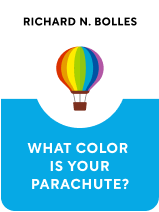

This article is an excerpt from the Shortform book guide to "What Color Is Your Parachute?" by Richard N. Bolles. Shortform has the world's best summaries and analyses of books you should be reading.
Like this article? Sign up for a free trial here .
Do you know how to implement the strategies of What Color Is Your Parachute? Can you use a What Color Is Your Parachute workbook?
The What Color Is Your Parachute workbook is a collection of strategies and activities for the process of job hunting. It includes tips for your resume, job search, and salary negotiation.
Keep reading for the What Color Is Your Parachute workbook.
What Color Is Your Parachute Workbook
Now that you know what job you’d like to do, the next step is to find an opportunity. The first thing to do is assess your online presence, because these days, employers learn just as much about you from the internet as they do from your resume.
There are four steps to creating a work-friendly online presence in the What Color Is Your Parachute workbook:
1. Delete. Search yourself and read all the results. Delete anything you or anyone else posted that doesn’t show you in a favorable light.
2. Bolster. Add information to your existing online profiles to make them more complete and keep them updated. LinkedIn is a particularly important one.
3. Add. Put more information about yourself online. Join online forums and groups, start a professional blog or video series, and create new professional accounts on sites such as Twitter.
4. Summarize. Now that you’ve increased your online presence, you want to create a summary of the information for those who don’t have time to look through everything. You’ll do this by creating a resume. To create a resume, brainstorm a list of all your skills, experiences, and so on, consulting your flower if necessary. Write your resume content and format it professionally. Then, post the resume online. You can post it on major job boards such as Monster or on specific companies’ websites. You can also send it to specific postings or employers.
Interviewing
Once your online presence or resume has secured you an employment interview, the next step of the job-hunt is to ace that interview. There are some guidelines for interviewing in the What Color Is Your Parachute workbook:
Before the Interview
1. Research the organization. Read the about page and press releases on their website, look for a file on the company at the library, and conduct informational interviews.
2. Test-run technology if you’re doing a video or phone interview.
3. Prepare samples. Bring relevant samples of work you’ve completed in the past.
4. Prepare a list of general skills. There are some general skills that all employers want, such as dependability, commitment, and trainability. Before your interview, make a list of these types of skills and an experience in which you’ve demonstrated that skill.
During the Interview
1. Keep your word. If you asked for the interview, don’t let the interview run on longer than the time you initially asked for.
2. Remember that interviews are a two-way conversation. An interview is a chance for you to learn about the employer as much as it is a chance for them to listen to you.
3. Speak and listen in equal measures. If you talk too much, employers might think you’ll ignore their organizations’ needs. If you listen too much, they might think you’re hiding something.
4. Prepare for common questions. Every question an interviewer asks you is related to one of these five underlying questions:
- Why are you interested in my organization specifically?
- What will you be able to do for us? What are you good at, what do you know, and if you were hired, would you solve our problems?
- Who are you? Will you fit in with the company culture?
- What’s unique about you? What makes you different from the other applicants?
- What will you want to be paid? Taking into account my budget and existing pay structure, is that possible?
No matter the question, try to give an answer with information that addresses some of the above questions.
Since interviewing is a two-way conversation according to the What Color Is Your Parachute workbook, you’re going to have approximately the same five questions for the employer:
- What are the tasks involved with the job? Ask this question aloud.
- What are the skills you’d need in order to excel at the job? Ask this question aloud.
- Are you going to fit in with the company culture? Use your observational skills to answer this question.
- What’s unique about me that I could share? This is where you bring up your traits—the adverbs and adjectives that describe how you execute your skills. Wait for an appropriate moment.
- Will they offer me an appropriate salary? (Don’t bring it up until it’s clear that the employer wants to hire you.)
- You may also want to ask some questions about how the company sees itself.
5. Answer all questions within 20 seconds to two minutes.
6. Reassure the employer that you’re not a risk. Bad hires are expensive—don’t do anything that suggests you’ll be a bad hire, such as showing up late.
7. Behave appropriately. Dress professionally, avoid nervous habits, be confident and polite, and demonstrate positive character traits.
8. Never speak badly of anyone. If you bad-mouth previous co-workers or employers, that suggests that you might do the same about your potential new employer and co-workers.
9. Concentrate on the future. Employers ask about past experiences in the hope of predicting how you’ll act in the future. Whenever you answer a question, try to anticipate what future behavior the employer is trying to predict and address it.
10. Assess the interview’s progress. Once you start getting questions about the distant future (where do you see yourself in ten years), you can assume the interview is going well. Now, ask more questions about the job such as what are the duties, who would you report to, and how does training work?
11. Ask final questions. After your final interview, if you like the employer and you think she likes you, ask about the next steps such as when you’ll hear back from her. Also, ask for business cards, or names and addresses, so you can send thank-you notes later.
After the Interview
There’s one to-do right after an interview: Send thank-you notes to everyone you meet, not only the person you interviewed with.
After Learning the Results
If you’re invited back for another interview or offered a job, congratulations! If you’re not, don’t be discouraged. Just because one employer didn’t hire you doesn’t mean another won’t.
What Color Is Your Parachute Workbook for Salary Negotiation
Congratulations, an employer likes you, you like them, and they’ve offered you a job! Now, it’s time to discuss salary and benefits.
There are six secrets to negotiating salary:
1. Research industry-standard salaries. Research salaries so that when an employer gives you a number, you know if it’s near the top or bottom of her company’s range. To research, search online, conduct more informational interviews, or find out what competitors or the government pays people in similar positions.
2. Wait for the opportune moment. Discuss salary only after the employer has decided she wants you. This puts you in a better position to negotiate.
3. Be prepared to negotiate. It’s your right.
4. Get the employer to mention a figure first. If an employer asks you for a number, respond by asking for her number—she came up with the job, so she must have some idea in mind.
5. Work the range. The bottom of your asking range should be near the top of the employer’s. For example, if an employer’s range is $40,000-$45,000, your range might be $44,000-$49,000.
6. Negotiate benefits. Benefits include life or medical insurance, vacation, and retirement contributions, and these can add 15-28% to a salary. As with salary, before going into an interview, you should know what you want.
Once you’ve finished all your negotiations, get everything you’ve discussed in writing and signed. Otherwise, an employer or supervisor might try to go back on what they offered.

———End of Preview———
Like what you just read? Read the rest of the world's best book summary and analysis of Richard N. Bolles's "What Color Is Your Parachute?" at Shortform .
Here's what you'll find in our full What Color Is Your Parachute? summary :
- How to not just find a job, but find a job you love
- Why traditional resumes don’t find you the right job
- The 7 steps to identifying your ideal career






